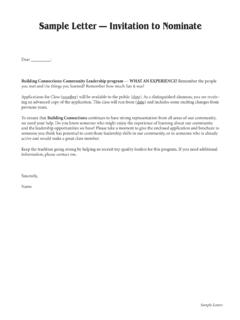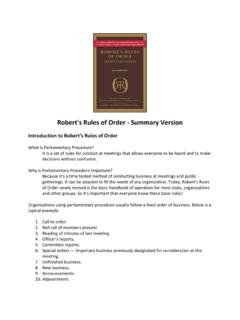Transcription of Leading Effective Meetings: Making Basic Parliamentary ...
1 Leading Effective Meetings: Making Basic Parliamentary Procedure Work Objectives: Define Parliamentary procedure Understand the key ingredients to running an Effective meeting Describe and discuss the reasons for using Parliamentary procedure in a meeting Recognize the importance of the use of an agenda Differentiate between types of motions and amendments Identify methods of voting Advance Preparation: Review the material provided in the lesson packet. Facilitator should have a Basic understanding of Parliamentary procedure. Materials Needed: Projection device The enclosed Power Point Presentation Bug cards cut out individually each participant should have 3-4 cards (Attachment 1). Robert's Rules of Order handout for each participant (Attachment 2). Parliamentary Procedure Lingo handout for each participant (Attachment 3). Handling a Motion handout for each participant (Attachment 4).
2 Parliamentary Procedures at a Glance handout for each participant (Attachment 5). meeting of the Minds Rate Yourself as a Participant handout for each participant (Attachment 6). Rate Yourself as a Leader handout for each participant (Attachment 7). Flip Charts Markers Time Needed: 1 hour Background Meetings often become stressful and chaotic when a group is attemting to make a decision based on consensus. Multiple individuals are attemtping to discuss at the same time while others sit in the back of the room and are disengaged from the topics being discussed. Meetings ran ineffectively result in arguments among participants, poor decisions being made, and people leaving the meeting feeling confused and frustrated. A Basic understanding of Parliamentary procedure leads to organized meetings and postive decision Making experiences for participants. Parliamentary procedure is an organized method of running Effective meetings.
3 The use of Parliamentary procedure provides a way of conducting business in a fair and democratic manner. The purpose is to help a group of decision makers accomplish their goals. It is important to understand that the rules of Parliamentary procedure are simply guidelines to follow, not laws. The most commonly used system of Parliamentary procedure is Roberts Rules of Order, which provides an in depth description of procedures used in conducting meetings. Parliamentary procedure can be intimidating, confusing, and boring especially for those who have had little or no expereince. Starting with the basics provides an understanding of the practical approach for running meetings. For an indepth review of Parliamentary procedure, one should refer to Roberts Rules of Order. Interest Approach To be completed at the beginning of the lesson. (Attachment 2). As participants enter the meeting room, hand out 3-4 bug cards to each participant.
4 On each card they should answer the question, What bugs me most about meetings is . Give participants 3-5 minutes to complete the exercise. After the group finishes the activity, discuss individual responses. As for volunteers to provide their responses and use the flip chart and markers to record responses. In most cases, you will get responses such as: one person dominating the discussion, arguments among the group, everyone talking at once, disorganization, lengthy meetings, etc. If these responses are not achieved, probe the group to come up with them. Explain to the group that most of the things that bug them about meetings can be overcome by knowing and applying Basic Parliamentary procedure. Lesson I. What is Parliamentary Procedure? a. Set of proven rules used to move business along during a meeting . b. Guidelines not laws. c. System that allows an organization to conduct business in a fair and democratic manner.
5 II. Why use Parliamentary Procedure? a. Handle only one item of business at a time b. All participants have an opportunity to participate in discussion c. Observe the rule of the majority d. Protect the rights of the minority Pass out the handout Robert's Rules of Order Basic Principles (Attachment 3). Discuss the basics with the group and make sure there is a general understanding. III. Using the Parli Pro Lingo a. Motion proposal or resolution by a member that the assembly take a certain action or express a certain view. A motion is considered out of order if it conflicts with the constitution or by-laws of the group b. Main Motion a motion to introduce a principal subject. Only one main motion may be considered at a time and must be disposed of before another main motion may be considered c. Motion to Lay on the Table a motion to lay aside a pending question for an indefinite amount of time d.
6 Motion to Take from the Table a motion enabling the assembly to resume consideration of a previously tabled item e. Point of Order to object to a proceeding as being in conflict with the rules of procedure. The chair must recognize the point f. Previous Questions a motion to end debate, which requires the assembly to vote on the issue at hand. The motion mnust be suspended, requires a 2/3 vote, and is not debatable g. Friendly Amendment a small change to an origional motion. Those who made and seconded the origional motion must agree to the amendment h. Motion to Adjourn a motion made at the conclusion of a business meeting or at the final business session i. Majority Vote more than half of the votes, or 50% +1. j. Quorum the number of members required in the by-laws to hold a legal meeting Pass out the handout Parliamentary Procedure Lingo (Attachment 4). Discuss the definitions with the group.
7 IV. Importance of the Agenda a. An agenda is a formal listing of business that is to be conducted at a meeting b. Usually developed by the chair and distributed to the members in advance c. Must be approved by the membership at the beginning of the meeting d. A well planned agenda is critical to a well run, organized meeting V. Sample Agenda a. Call to Order chair begins the meeting at the published time by saying something like The meeting will now come to order.. b. Roll Call (if appropriate) this is a legal requirement for some organizations. The minutes must list the names of those present and absent. Most civic organizations and community groups don't need to record members present by taking roll call. c. Adoption of the Agenda members should be sent a copy of the agenda prior to the meeting . At the beginning of the meeting , the chair calls for a motion to adopt the agenda.
8 Less formal groups don't need to formally adopt the agenda. d. Approval of Minutes from Previous meeting minutes should be sent out with the agenda prior to the meeting for members to read. If there are no changes, the minutes are approved without a motion or voting. e. Reports of Officers typical officer reports include the treasurer and secretaries reports. f. Reports of Committees prior to the meeting , the chair should check with committees to see what progress is being made and to find out if they have a report for the group. g. Unfinished Business these are items pending from previous meetings. h. New Business new business items should be listed on the agenda. i. Announcements annoucements should be listed on the agenda to avoid meetings that don't stop. j. Adjournment VI. Role of meeting Participants a. It is the participants responsibility to establish and maintain Effective meeting structure b.
9 All participants have the right and responsibility to participate in meetings and in Parliamentary procedure c. Participants should know the Constitution and By-Laws of the organization d. Be involved in discussion! strong group discussion leads to strong decisions being made. VII. Keys to Effective Meetings a. Parliamentary procedure is based on motions b. The key to Parliamentary procedure is learning and understanding these motions c. Don't become overwhelmed by the list of motions -- concentrate on those that will be used on a regular basis d. REMEMBER using Parliamentary procedure take patience, practice, and a lot of effort!!!! VIII. Use of the Gavel a. The gavel allows the chair to obtain attention quickly b. One tap signals for members (participants) to be seated and follows the completion of an item of business or announces adjournment c. Two taps calls a meeting to order d.
10 Three taps signals for members to stand e. Series of taps restores order of the room IX. Methods of Voting There are 4 common methods of voting: 1. Voice Vote works in small groups but not large. With a large group it's hard to distinguish quanity. 2. Rising Vote either hand or physically rising. This is the most common method of voting. The chair counts in response to those in favor and those against. 3. Secret Ballot secretary distributes, collects, tallies, and reports the decision to the chair who announces the result. 4. Roll Call each member is asked how they vote by the chair. a. Quorum review definitions from earlier b. Simple Majority c. Two-thirds Vote X. Motions each of these motions will be discussed in detail a. Main Motions b. Privileged Motions c. Subsidiary Motions d. Incidental Motions e. Unclassified Motions XI. Main Motions a. Introduces a principal subject.







